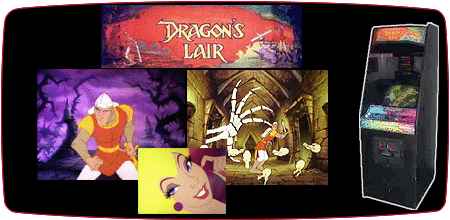Dragon's Lair

Retro Coin Op Synopsis
“Lead on, adventurer, your quest awaits…”
For those who weren’t there, try to imagine the shock of seeing this game back in 1983. Games like Crystal Castles and Mario Bros. had pretty cool graphics, but Dragon’s Lair was an honest-to-goodness cartoon, hand-designed by The Secret of NIMH director Don Bluth (later responsible for An American Tail and The Land Before Time, among others). There was no ignoring it—Dragon’s Lair practically blew away everything else in the arcade.
In fairness to Crystal Castles and Mario Bros., Dragon’s Lair wasn’t as fully interactive as its video game contemporaries. The game was made possible through the use of Laserdisc technology, whereby Bluth and company were able to animate several scenarios for each scene, essentially making a full-motion Choose Your Own Adventure story. If the correct choices were made, the hero lived on to face the next challenge. If not, the animation skipped to a brief, grotesque, often hilarious death scene.
The game starred Dirk the Daring, an heroic but not always bright knight in shining armor. The voluptuous Princess Daphne had been kidnapped by the dragon Singe, and Dirk stormed the beast’s lair to get her back. From the entrance on, there was no set pattern for your individual adventure. Scenes were accessed randomly, though they were grouped in increasing levels of difficulty.
Within 22 minutes of animation, Dirk faced such nightmares as snakes, spiders, vampire bats, giant spinning batons, electrified fences and floors, dangerous potions, a flying metal horse, the purple Giddy Goons, the enchanted Smithee, the Lizard King, the Crypt Creeps, Mud Men, the Black Knight (on more than one occasion) and finally Singe himself. To further throw off players, the rooms were often reversed, so memorized patterns weren’t always foolproof. With so much full-motion animation and so many split-second decisions to make, Dragon’s Lair made players feel like they were part of an interactive movie, and they loved it.
Six years and 1.3 million dollars in the making, Dragon’s Lair was the result of a collaboration involving Bluth, game designer Rick Dyer and Space Wars creators Cinematronics. The latter was in dire financial straits by the time the game was released in 1983, but Dragon’s Lair was an instant hit, pulling in quarters by the millions and drawing the attention of national news organizations. Dragon’s Lair got its own Saturday morning cartoon, as well as a large line of tie-in merchandise. Laserdisc games entered a mini-boom, spawning titles like Firefox, M.A.C.H. 3, and the Bluth/Dyer/Cinematronics follow-up, Space Ace.
The high times were short-lived, however. The fledgling technology was notoriously temperamental, causing several breakdowns and not a few headaches for arcade owners. Furthermore, once the game was over, there were no harder levels to beat. “Cheat sheets” hit the video game grapevine, and soon even novice Dragon’s Lair players knew how to beat the machine. The Laserdisc phenomenon died out as quickly as it had been born, leaving only one true superstar: Dragon’s Lair.
The creators had been working on a sequel since 1983, but the end of the boom put production on hold. In 1991, Dragon’s Lair II: Timewarp was finally released by the Leland Corporation. In the new adventure, Dirk and Daphne were married with children (several), but the evil wizard Mordrec appeared and kidnapped the lovely princess. After escaping his wife’s battleaxe mother, Dirk set out to find the wizard. Using a broken-down time machine, Dirk chased Mordrec through real and fantasy history, battling Alice in Wonderland villains, Beethoven’s cat, Egyptian mummies and even Daphne herself, transformed into an enormous purple beast.
The sequel didn’t make as much of a splash as the original, but it kept the legend alive for die-hard Dragon’s Lair enthusiasts. Faithful home computer versions of the original appeared in the early 1990’s, continuing to win new players throughout the decade. Fans’ patience and enthusiasm were finally rewarded in May of 1999 with the announcement of a new installment, Dragon’s Lair 3-D, due in PC and Macintosh formats in the not-too-distant future.
Arcade Machine Release History
1983 - Dragon's Lair1991 - Dragon's Lair II: Timewarp
